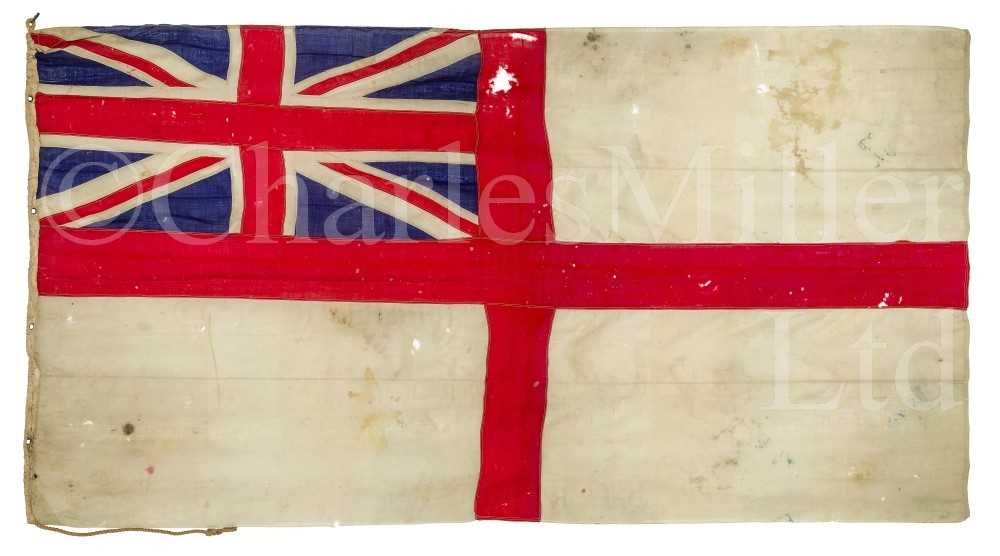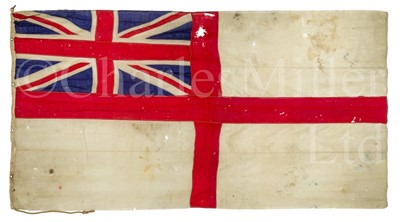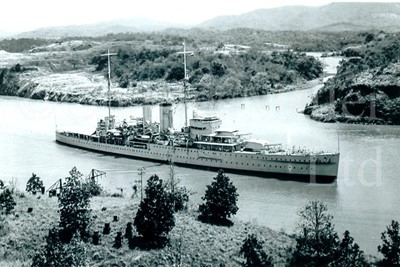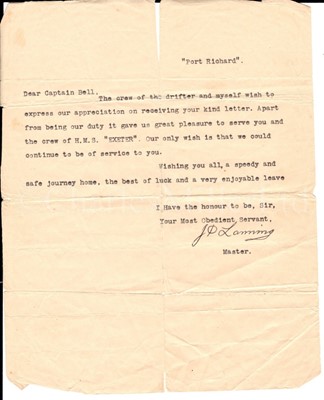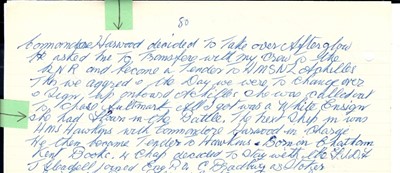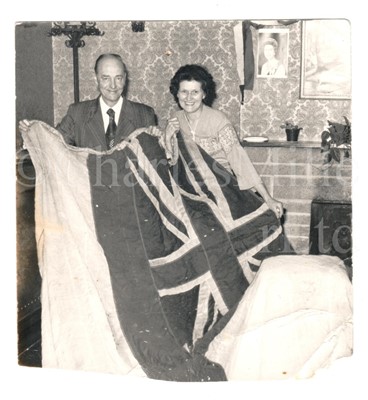2nd Nov, 2021 10:00
Maritime and Scientific Models, Instruments & Art (Zephyr)
318
[M] H.M.S. EXETER'S BATTLE ENSIGN FLOWN DURING THE ACTION AGAINST S.M.S. ADMIRAL GRAF SPEE AT THE BATTLE OF THE RIVER PLATE, 13TH DECEMBER, 1939
A WHITE 'BATTLE' ENSIGN FLOWN BY H.M.S. EXETER DURING THE ACTION AGAINST S.M.S. ADMIRAL GRAF SPEE AT THE BATTLE OF THE RIVER PLATE, 13TH DECEMBER, 1939
of regulation pattern, constructed in stitched bunting with canvas sleeve threaded with rope lanyard (scattered holes and staining throughout) -- 73 x 147in. (185 x 373cm.); together with a quantity of ephemera including a letter on Exeter stationery from Captain F.S. Bell; and a manuscript memoir by Lanning which mentions the presentation of the ensign in 1940
(a lot)
Provenance: Joseph P. Lanning (1898-1989), Harbour Master, Port Stanley (1939) and thence by descent.
A Falkland Islander by birth, by 1939 Joseph Lanning held several positions within the community including that of a part-time harbour master and a police constable. He also happened to be Master of the ‘official’ steam trawler Port Richard and consequently was heavily involved when Commodore Harwood's badly damaged flagship limped into Port Stanley shortly after their dramatic action with Admiral Graf Spee. After escorting Exeter to a safe mooring, the Port Richard was pressed into service as tender (Exeter's boats having all succumbed in action) and having to cope with her crew of 660 of which 63 had been killed and a further 23 seriously wounded. Exeter herself was little more than a floating ruin and required emergency repairs sufficient to get her back to the UK for a full refit. A short while later, H.M.S. Ajax arrived to refuel and also have her wounded attended to and so Lanning now had responsibility for yet another ship full of exhausted and wounded men. In a memoir composed in retirement, he noted, somewhat ruefully, that after his supreme efforts All I got was a White Ensign she had flown in battle, although the captain of Exeter and the Falkland Island's governor also wrote personal notes of effusive thanks. The Port Richard was transferred to the Royal Navy as H.M. Trawler Afterglow, with Lanning retained as skipper, but she was damaged in the Reef Channel and laid up in Port Stanley before being driven ashore and wrecked in a gale. Later in life, Lanning moved to the UK and proudly retained Exeter's ensign and the union flag from Afterglow as souvenirs.
The Battle of the River Plate
When WWII broke out on 3rd September, 1939, the 'pocket battleship' Graf Spee was already in the South Atlantic although, despite Germany's invasion of Poland on 1st September, Hitler was initially convinced that Great Britain and France would negotiate for an early peace. To this end, he kept German warships away from the commercial shipping lanes as he awaited developments and Graf Spee stood off the South American coast in company with her supply ship Altmark for almost three weeks before finally receiving orders to assume the offensive. On 20th September, Langsdorff sank his first victim, the Booth Line's steamer Clement, 60 miles off Pernambuco, and in just over two months, he sank a further nine British merchantmen. His dislike of unnecessary bloodshed, however, coupled with the extraordinarily humane treatment of his prisoners whom he put aboard Altmark, earned him the grudging respect of even those captains whose ships he had sunk beneath them although it was not until Altmark herself was captured off Norway the following February that the full story emerged. The Admiralty meanwhile, realising that Langsdorff had to be stopped as much to allay public concern at home as to prevent further shipping losses, mounted an urgent operation to hunt and destroy Graf Spee as rapidly as possible. Commodore Henry Harwood, senior Royal Navy officer in the area, was given command and his flotilla - designated Force 'G' - consisted of the heavy cruiser H.M.S. Exeter and two light cruisers, Ajax and Achilles, the latter seconded from the Royal New Zealand Navy. In theory at least, Force 'G' was easily capable of dealing with a single enemy heavy cruiser; in practice, however, the considerable strengths of the so-called 'pocket battleship' were such that Harwood knew he faced a formidable task even allowing for the fact that he would first have to locate Graf Spee and corner her somewhere in the vastness of the South Atlantic.
Intuition suggested the wide estuary of the River Plate, a vital crossroads for many South American trade routes, and Harwood's fitness for command soon proved itself when Force 'G' sighted the smoke of an unknown vessel on the horizon early on the morning of 13th December. Exeter approached to investigate and instantaneously with Harwood's confirmation that the stranger was indeed Graf Spee, Langsdorff had spotted his pursuers, rung up 'battle stations' and was steaming into action at full speed. Harwood wisely divided his force so as to minimise the effects of the enemy's main armament but not before all three of his ships had become targets. Langsdorff opened fire at approximately 6.20am. and concentrated his port salvoes on Exeter whilst his starboard guns dealt with Ajax and Achilles. Exeter bore the brunt of accurate German gunnery and by 7 o'clock she had received between 40 and 50 hits and lost two turrets. Half an hour later, her last turret was silenced and she was forced to withdraw from the action, severely damaged and with heavy casualties including 53 dead. The light cruisers fought on obstinately, despite the overwhelming odds, and even though they too were damaged - especially Ajax - their dogged tenacity probably saved Exeter and decided the outcome of the battle. Unknown to them, Langsdorff had become concerned that he was vulnerable to a combined torpedo attack and that fear, coupled with the realisation that Graf Spee had actually been hit 20 times by British shells, provoked a surprising reaction and he broke off the engagement to run for shelter in the Plate Estuary 300 miles to the west.
Racing past and ignoring a homeward-bound British merchantman the Shakespeare, Graf Spee made the neutral port of Montevideo after a 12-hour dash pursued by Ajax and Achilles. Britain immediately requested the Uruguayan authorities to expel Graf Spee within 24 hours or intern her under the provisions of International Law, thereby initiating a frenzied burst of diplomatic activity worthy of the most popular fiction. Despite the best efforts of both Langsdorff and the German Ambassador, the permitted stay was only extended to 72 hours and Langsdorff, surrounded by rumours of approaching British reinforcements, was faced with a bitter choice. As the 8.00pm. deadline neared on 17th December, Langsdorff took his second fateful decision and having released the few British prisoners still aboard his ship, and bidding farewell to those who had given him sanctuary in Montevideo, ordered Graf Spee to make ready to sail. Clearing her moorings at 6.15pm., she made for the open sea followed by the German steamer Tacoma. With her battle ensigns flying, she stopped engines at the three-mile limit and there, in full view of Ajax and Achilles, she suddenly and unexpectedly blew up and destroyed herself with pre-set explosives. Her crew were taken aboard Tacoma which proceeded to Buenos Aires where, on 20th December, Captain Langsdorff took his own life rather than face the ignominy of surrender and internment.
It was a tragic end for a man who, by then, had earned the admiration of those who were hunting him down as well as those who had suffered loss at his hands. To many, he epitomised the chivalry of an earlier age and even though he had sunk over 50,000 tons of British merchant shipping, not a single allied life had been lost aboard any of those vessels. In fact, his conduct throughout the Graf Spee's final commission was such that he was, and still is, universally regarded as one of the last gentleman raiders in the history of war at sea.
Admiral Graf Spee, the third of the 'Deutschland' class cruisers [the so-called 'pocket battleships'] was laid down in 1932, launched in 1934 and completed in January 1936. Displacing 11,700 tons, she measured 610 feet in length with a 71-foot beam, and could make 28 knots under full power. Her design, as a fast heavily-armed though lightly-armoured long-range merchant raider, proved a triumph and had all eight of the class been built instead of three which were completed, the Royal Navy would probably have faced an impossible task given that it had only three capital ships capable of matching their speed.
Sold for £31,000
Estimated at £2,000 - £3,000
(inc. buyer's premium of 24%)
A WHITE 'BATTLE' ENSIGN FLOWN BY H.M.S. EXETER DURING THE ACTION AGAINST S.M.S. ADMIRAL GRAF SPEE AT THE BATTLE OF THE RIVER PLATE, 13TH DECEMBER, 1939
of regulation pattern, constructed in stitched bunting with canvas sleeve threaded with rope lanyard (scattered holes and staining throughout) -- 73 x 147in. (185 x 373cm.); together with a quantity of ephemera including a letter on Exeter stationery from Captain F.S. Bell; and a manuscript memoir by Lanning which mentions the presentation of the ensign in 1940
(a lot)
Provenance: Joseph P. Lanning (1898-1989), Harbour Master, Port Stanley (1939) and thence by descent.
A Falkland Islander by birth, by 1939 Joseph Lanning held several positions within the community including that of a part-time harbour master and a police constable. He also happened to be Master of the ‘official’ steam trawler Port Richard and consequently was heavily involved when Commodore Harwood's badly damaged flagship limped into Port Stanley shortly after their dramatic action with Admiral Graf Spee. After escorting Exeter to a safe mooring, the Port Richard was pressed into service as tender (Exeter's boats having all succumbed in action) and having to cope with her crew of 660 of which 63 had been killed and a further 23 seriously wounded. Exeter herself was little more than a floating ruin and required emergency repairs sufficient to get her back to the UK for a full refit. A short while later, H.M.S. Ajax arrived to refuel and also have her wounded attended to and so Lanning now had responsibility for yet another ship full of exhausted and wounded men. In a memoir composed in retirement, he noted, somewhat ruefully, that after his supreme efforts All I got was a White Ensign she had flown in battle, although the captain of Exeter and the Falkland Island's governor also wrote personal notes of effusive thanks. The Port Richard was transferred to the Royal Navy as H.M. Trawler Afterglow, with Lanning retained as skipper, but she was damaged in the Reef Channel and laid up in Port Stanley before being driven ashore and wrecked in a gale. Later in life, Lanning moved to the UK and proudly retained Exeter's ensign and the union flag from Afterglow as souvenirs.
The Battle of the River Plate
When WWII broke out on 3rd September, 1939, the 'pocket battleship' Graf Spee was already in the South Atlantic although, despite Germany's invasion of Poland on 1st September, Hitler was initially convinced that Great Britain and France would negotiate for an early peace. To this end, he kept German warships away from the commercial shipping lanes as he awaited developments and Graf Spee stood off the South American coast in company with her supply ship Altmark for almost three weeks before finally receiving orders to assume the offensive. On 20th September, Langsdorff sank his first victim, the Booth Line's steamer Clement, 60 miles off Pernambuco, and in just over two months, he sank a further nine British merchantmen. His dislike of unnecessary bloodshed, however, coupled with the extraordinarily humane treatment of his prisoners whom he put aboard Altmark, earned him the grudging respect of even those captains whose ships he had sunk beneath them although it was not until Altmark herself was captured off Norway the following February that the full story emerged. The Admiralty meanwhile, realising that Langsdorff had to be stopped as much to allay public concern at home as to prevent further shipping losses, mounted an urgent operation to hunt and destroy Graf Spee as rapidly as possible. Commodore Henry Harwood, senior Royal Navy officer in the area, was given command and his flotilla - designated Force 'G' - consisted of the heavy cruiser H.M.S. Exeter and two light cruisers, Ajax and Achilles, the latter seconded from the Royal New Zealand Navy. In theory at least, Force 'G' was easily capable of dealing with a single enemy heavy cruiser; in practice, however, the considerable strengths of the so-called 'pocket battleship' were such that Harwood knew he faced a formidable task even allowing for the fact that he would first have to locate Graf Spee and corner her somewhere in the vastness of the South Atlantic.
Intuition suggested the wide estuary of the River Plate, a vital crossroads for many South American trade routes, and Harwood's fitness for command soon proved itself when Force 'G' sighted the smoke of an unknown vessel on the horizon early on the morning of 13th December. Exeter approached to investigate and instantaneously with Harwood's confirmation that the stranger was indeed Graf Spee, Langsdorff had spotted his pursuers, rung up 'battle stations' and was steaming into action at full speed. Harwood wisely divided his force so as to minimise the effects of the enemy's main armament but not before all three of his ships had become targets. Langsdorff opened fire at approximately 6.20am. and concentrated his port salvoes on Exeter whilst his starboard guns dealt with Ajax and Achilles. Exeter bore the brunt of accurate German gunnery and by 7 o'clock she had received between 40 and 50 hits and lost two turrets. Half an hour later, her last turret was silenced and she was forced to withdraw from the action, severely damaged and with heavy casualties including 53 dead. The light cruisers fought on obstinately, despite the overwhelming odds, and even though they too were damaged - especially Ajax - their dogged tenacity probably saved Exeter and decided the outcome of the battle. Unknown to them, Langsdorff had become concerned that he was vulnerable to a combined torpedo attack and that fear, coupled with the realisation that Graf Spee had actually been hit 20 times by British shells, provoked a surprising reaction and he broke off the engagement to run for shelter in the Plate Estuary 300 miles to the west.
Racing past and ignoring a homeward-bound British merchantman the Shakespeare, Graf Spee made the neutral port of Montevideo after a 12-hour dash pursued by Ajax and Achilles. Britain immediately requested the Uruguayan authorities to expel Graf Spee within 24 hours or intern her under the provisions of International Law, thereby initiating a frenzied burst of diplomatic activity worthy of the most popular fiction. Despite the best efforts of both Langsdorff and the German Ambassador, the permitted stay was only extended to 72 hours and Langsdorff, surrounded by rumours of approaching British reinforcements, was faced with a bitter choice. As the 8.00pm. deadline neared on 17th December, Langsdorff took his second fateful decision and having released the few British prisoners still aboard his ship, and bidding farewell to those who had given him sanctuary in Montevideo, ordered Graf Spee to make ready to sail. Clearing her moorings at 6.15pm., she made for the open sea followed by the German steamer Tacoma. With her battle ensigns flying, she stopped engines at the three-mile limit and there, in full view of Ajax and Achilles, she suddenly and unexpectedly blew up and destroyed herself with pre-set explosives. Her crew were taken aboard Tacoma which proceeded to Buenos Aires where, on 20th December, Captain Langsdorff took his own life rather than face the ignominy of surrender and internment.
It was a tragic end for a man who, by then, had earned the admiration of those who were hunting him down as well as those who had suffered loss at his hands. To many, he epitomised the chivalry of an earlier age and even though he had sunk over 50,000 tons of British merchant shipping, not a single allied life had been lost aboard any of those vessels. In fact, his conduct throughout the Graf Spee's final commission was such that he was, and still is, universally regarded as one of the last gentleman raiders in the history of war at sea.
Admiral Graf Spee, the third of the 'Deutschland' class cruisers [the so-called 'pocket battleships'] was laid down in 1932, launched in 1934 and completed in January 1936. Displacing 11,700 tons, she measured 610 feet in length with a 71-foot beam, and could make 28 knots under full power. Her design, as a fast heavily-armed though lightly-armoured long-range merchant raider, proved a triumph and had all eight of the class been built instead of three which were completed, the Royal Navy would probably have faced an impossible task given that it had only three capital ships capable of matching their speed.
Auction: Maritime and Scientific Models, Instruments & Art (Zephyr), 2nd Nov, 2021
Mercantile (Sail) – 1-92A
Mercantile (Steam) – 93-151
Naval (Sail) – 155-236
Naval (Steam) – 240-340
Navigation & Scientific Instruments – 341-392
You will not be able to bid in person for this sale, however, there are a number of ways you can still participate:
- Absentee bid – you can place a bid through your account on this website or download a bid form here
- Online via one of the following platforms:
UKAuctioneers: 3% surcharge or a flat-rate fee of £3.95. We will refund the flat-rate fee for successful bidders using the UK Auctioneers service
Invaluable: 3% surcharge
The Saleroom: 5% surcharge
We regret we are unable to offer telephone bidding for this sale
Viewing
Viewing by appointment only from Monday, 11 October until Monday, 1 November, 10am-5pm
Please call or email to book a slot 020 7806 5530 | enquiries@charlesmillerltd.com
